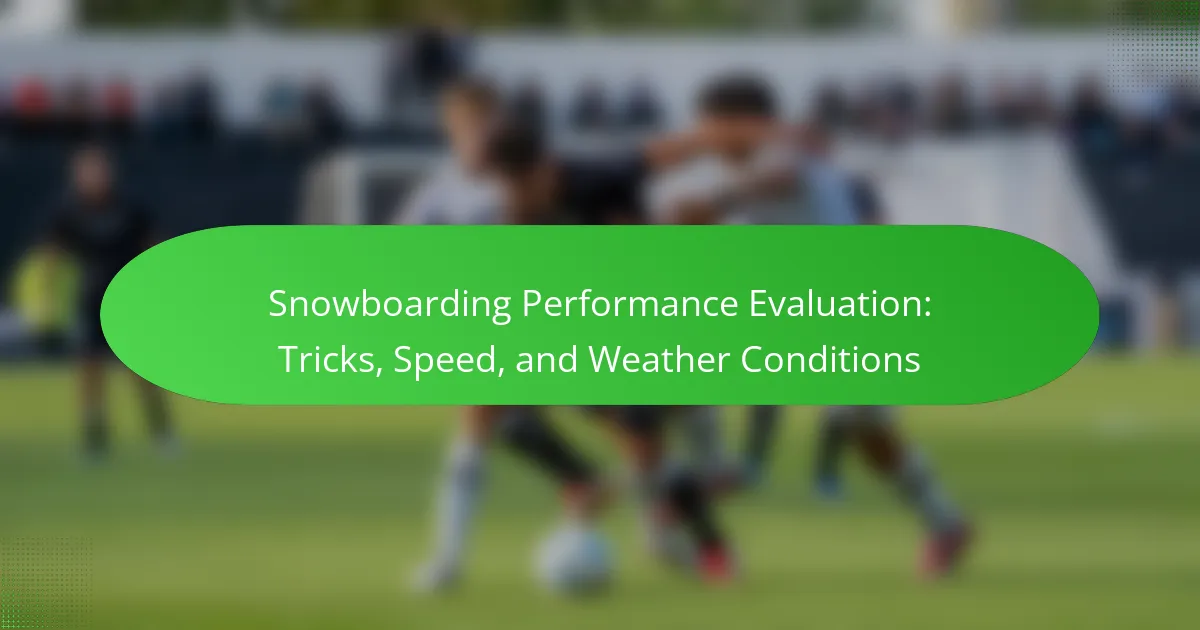Evaluating snowboarding performance is crucial for athletes aiming to enhance their skills. Key factors include technique mastery, optimal speed, and understanding weather conditions. Techniques like jumps and grabs impact execution, while speed influences control and scoring. Weather conditions, such as snow texture and temperature, play a vital role in performance outcomes.

What are the key factors influencing snowboarding performance?
Key factors influencing snowboarding performance include technique, speed, and environmental conditions. Technique impacts execution of tricks and overall control. Speed affects stability and maneuverability, while weather conditions influence snow quality and visibility.
The following aspects further detail these influences:
1. Technique: Mastery of carving, jumping, and landing techniques enhances performance.
2. Speed: Optimal speed allows for better control during tricks and turns.
3. Weather Conditions: Snow texture, wind, and temperature can significantly affect grip and performance.
Understanding these factors helps snowboarders optimise their skills and adapt to varying conditions.
How do tricks impact overall performance in snowboarding?
Tricks significantly enhance overall performance in snowboarding by improving style and control. Mastering tricks can lead to higher scores in competitions, showcasing technical skill and creativity. Additionally, tricks can affect speed and momentum, as they often require precise timing and body positioning. Weather conditions also play a role, influencing the execution of tricks and overall performance. For example, fresh powder may allow for smoother landings, while icy conditions can make tricks more challenging.
What role does speed play in snowboarding evaluation?
Speed significantly influences snowboarding performance evaluation by affecting trick execution and overall control. Higher speeds can enhance the difficulty of tricks, showcasing a rider’s skill. However, excessive speed may lead to loss of control, impacting safety and performance. Evaluators consider speed alongside technique and adaptability to weather conditions, as these factors collectively determine a rider’s effectiveness on the slopes. Balancing speed with precision is essential for optimal performance in competitions and recreational riding.
How do weather conditions affect snowboarding performance?
Weather conditions significantly impact snowboarding performance by affecting snow quality, visibility, and rider comfort. For instance, warmer temperatures can lead to slushy snow, which slows down speed and alters trick execution. Conversely, cold weather typically results in firmer snow, enhancing speed and stability. Wind can reduce visibility, making it challenging to navigate terrain and perform tricks safely. Additionally, precipitation like rain or snow can change the surface texture, influencing grip and control. Understanding these factors helps snowboarders adapt their techniques and gear for optimal performance.

Which tricks are essential for competitive snowboarding?
Essential tricks for competitive snowboarding include the following: frontside and backside 180s, 360s, and grabs like the mute and melon. Mastering these tricks enhances performance and adaptability in various weather conditions. Each trick contributes to overall score and style in competitions. Focus on perfecting execution and timing for maximum impact.
What are the most common beginner tricks in snowboarding?
The most common beginner tricks in snowboarding include the heel edge slide, toe edge slide, and basic ollie. These tricks focus on balance and control, essential for building confidence on the slopes. Progressing to the 180-degree spin and the basic jump enhances a rider’s skills. Beginners should practice these tricks in safe, controlled environments to improve their snowboarding performance.
How do advanced tricks differ from beginner techniques?
Advanced tricks require more skill and precision than beginner techniques. Beginners typically focus on foundational maneuvers like basic turns and stops, while advanced riders perform complex tricks such as flips and spins. Advanced techniques demand higher speed, better balance, and an understanding of weather conditions affecting performance. Additionally, advanced tricks often involve unique attributes like aerial maneuvers and technical landings, which are rarely executed by beginners. Mastery of these advanced techniques significantly enhances overall snowboarding performance.
What unique tricks are popular in specific regions?
Unique snowboarding tricks vary by region due to cultural influences and terrain. In the United States, the “Double Cork” is popular for its complexity. In Japan, “Method” grabs are favoured for style. Europe often showcases “Backside 180s” for versatility. Each region emphasises tricks that align with local snow conditions and rider preferences.

How does speed influence scoring in snowboarding competitions?
Speed significantly influences scoring in snowboarding competitions by enhancing performance and trick execution. Faster speeds allow athletes to generate more momentum, which can lead to higher amplitude in jumps and more complex trick combinations. Judges often reward speed as it reflects control and confidence, contributing to overall scores. Additionally, the relationship between speed and scoring can vary based on weather conditions, such as snow texture and wind, impacting both performance and scoring potential.
What are the optimal speed ranges for different types of snowboarding events?
Optimal speed ranges for snowboarding events vary by type. For slalom and giant slalom, speeds typically range from 30 to 50 km/h. In freestyle events, speeds are generally lower, around 15 to 25 km/h, to allow for trick execution. For downhill racing, speeds can exceed 80 km/h, with elite athletes reaching up to 120 km/h. Weather conditions, such as snow quality and wind, can also influence these speed ranges.
How is speed measured during snowboarding evaluations?
Speed during snowboarding evaluations is measured using radar guns or GPS devices. These tools provide real-time speed data, allowing evaluators to assess performance accurately. Radar guns capture speed by bouncing radio waves off the snowboarder, while GPS devices track movement through satellite signals. Both methods ensure precise speed readings, critical for evaluating a snowboarder’s agility and technique.

What weather conditions are most conducive to optimal snowboarding performance?
Optimal snowboarding performance thrives in cold, dry conditions with minimal wind. Ideal temperatures range from -6°C to -1°C, ensuring snow remains powdery and manageable. Low humidity enhances visibility and grip. Sunny days boost morale, but overcast conditions can provide better light for tricks.
How do temperature and snow type affect snowboarding?
Temperature and snow type significantly influence snowboarding performance. Warmer temperatures typically lead to softer snow, enhancing grip and speed, while colder conditions create harder, icier surfaces that can challenge control.
Snow type, such as powder, slush, or groomed, affects maneuverability and technique. Powder provides a unique, buoyant experience, enabling tricks like floating turns, while slush can slow down speed and require more effort to navigate.
Understanding these factors helps snowboarders adapt their techniques and expectations based on weather conditions, ultimately improving their performance on the slopes.
What rare weather phenomena can enhance or hinder snowboarding experiences?
Rare weather phenomena can significantly impact snowboarding experiences, enhancing or hindering performance. Examples include fog, which reduces visibility and can hinder navigation. Conversely, a light snowfall can create powder conditions that enhance trick execution and speed.
Other rare phenomena like freezing rain can create icy surfaces, making it difficult to maintain control. Additionally, sudden temperature drops can lead to hard-packed snow, affecting speed and trick performance. Understanding these conditions helps snowboarders prepare better for their outings.

What are the best practices for evaluating snowboarding performance?
To evaluate snowboarding performance effectively, focus on tricks, speed, and weather conditions. Tracking the number and complexity of tricks executed highlights skill level. Measuring speed provides insight into control and confidence on the slopes. Additionally, assessing weather conditions, such as snow quality and temperature, influences performance outcomes. These factors together create a comprehensive evaluation framework.
How can athletes assess their own performance effectively?
Athletes can effectively assess their snowboarding performance by focusing on tricks, speed, and weather conditions. Analyzing these factors helps identify strengths and areas for improvement.
To evaluate tricks, athletes should record their attempts, noting success rates and difficulty levels. For speed, using a GPS device can provide accurate metrics on speed and distance travelled. Weather conditions, including temperature and snow quality, significantly impact performance; athletes should track these to understand their effects on riding.
Regularly reviewing this data allows athletes to adjust training techniques and strategies, enhancing overall performance.
What common mistakes should be avoided during performance evaluations?
Common mistakes during snowboarding performance evaluations include overlooking individual skill levels, failing to account for weather conditions, and neglecting to assess specific tricks. These factors significantly impact performance metrics. Additionally, evaluators often focus too much on speed without considering technique, leading to an incomplete assessment. Lastly, not providing constructive feedback can hinder improvement.
What expert tips can enhance snowboarding performance assessments?
To enhance snowboarding performance assessments, focus on precise technique analysis, speed metrics, and environmental factors. Use video analysis to capture tricks and form. Incorporate speed sensors to measure velocity on various terrains. Assess weather conditions, as they significantly impact performance.
